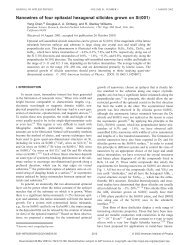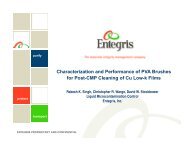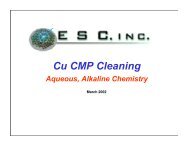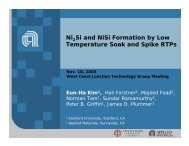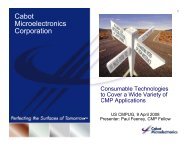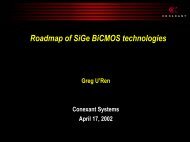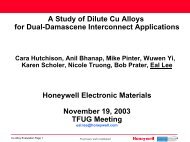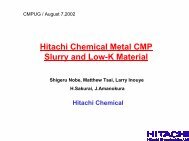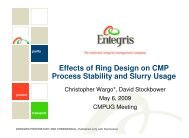Sidewall Passivation Mechanism of CH x F y Added Polysilicon
Sidewall Passivation Mechanism of CH x F y Added Polysilicon
Sidewall Passivation Mechanism of CH x F y Added Polysilicon
- No tags were found...
You also want an ePaper? Increase the reach of your titles
YUMPU automatically turns print PDFs into web optimized ePapers that Google loves.
<strong>Sidewall</strong> <strong>Passivation</strong> <strong>Mechanism</strong><strong>of</strong> <strong>CH</strong> x F y <strong>Added</strong> <strong>Polysilicon</strong>Gate Etch ProcessesTh. Lill, F. Ameri, S. Deshmukh, Songlin Xu, D. Podlesnik, J. HollandApplied Materials, Silicon Etch Division, Santa Clara, USAL. Vallier, O. JoubertCNRS/LTM, Grenoble, FrancePEUG MeetingSunnyvale, January 2002Conductor Etch Organization
Key Factors for Control <strong>of</strong> CriticalDimensionsWafer RFStateChamberWallConditionsProcess Chemistry*dense - isoProcessPerformanceGas Transport andResidence timesPlasmaTechnologycenter-edgeDiagnosticsand Sensorswafer-waferWafer ThermalStateConductor Etch Organization
Outline• Evidence for carbon formation with HBr / CF 4 gas mixture• XPS data for CF 4 containing gate etch processes• Line width evolution for CF 4 free and CF 4 added processes• Model for sidewall passivation mechanism• Dual gate etching behavior for CF 4 added gate processesConductor Etch Organization
Possible designs <strong>of</strong> selfcleaning gate processesEtch Deposition(on chamber parts)maskWSi xPoly-SiCl 2, CF 4, N 2orCl 2, SF 6, N 2HBr, Cl 2, HeO 2HBr, HeO 2gate oxidetimemaskPoly-SiHBr, Cl 2, CF 4, HeO 2orCl 2, CF 4, N 2HBr, HeO 2gate oxidetimeSee also: Tammy Zheng et al., PEUG 11/99Conductor Etch Organization
Wall deposition / SiO 2 removal vs. CF 4 concentration40Deposition rate (Å/min)200-20-40-60-80-1000 5 10 15 20 25 30Measured with QCM / coupon technique.(4 mTorr / total flow 200 sccm / W s/W b= 5 :1)CF 4 /(CF 4 +HBr+Cl 2 )CF 4 added gate chemistry is cleaning walls for sufficiently high flows.P. NallanConductor Etch Organization
Experimental evidence for the existence <strong>of</strong> carbonbased polymer depositionHBr/CF4=4:1; CF4/O2=8:1, 8 sccm HeO2; 25 sccm CF4; 40 % Cl2, 4 mTorr; Ws/Wb=10:1; 1hConductor Etch Organization
Comparison <strong>of</strong> Polymer Decomposition Spectrumwith CO 2 Emission SpectrumCO 2 plasmaIntensityO 2 plasma with polymer formedin 50HBr+50CF 4 plasmaFormation: 100sccm(HBr+CF 4), 6mTorr, 600WsDetection: 100O 2, 6mTorr, 600WsWavelength (nm)CO 2 plasma and O 2 decompositionspectrum for polymer covered wallshow similar signature - indicationthat polymer is carbon based.Conductor Etch Organization
Chamber wall polymer compositionvs. HBr / CF 4 ratio-C-90HBr+10CF 4F(685.6 nm)F(703.7 nm)80HBr+20CF 4CFC-CFx70HBr+30CF 460HBr+40CF 450HBr+50CF 4CF 2CFC-CFx-C-40HBr+60CF 4CF 3Formation: 100sccm(HBr+CF 4 ), 6mTorr, 600WsDetection: 100O 2 , 6mTorr, 600WsPolymer contains more fluorinewhen CF 4 flow is increased.For comparison:Chamber wall polymer created by<strong>CH</strong> 2 F 2 plasma.Conductor Etch Organization
Correlation between Polymer thickness and composition801.4Polymer Removal Time (sec)706050403020101.31.21.11.00.90.80.70.60.50.40.30.2F Density (a.u)00.10.00 10 20 30 40 50 60 70 80CF 4Percentage in feed gasDeposition: 100sccm(HBr+CF 4 ), 6mTorr, 600Ws, 0Wb, blank oxide waferRemoval: 100O 2 , 6mTorr, 600WsPolymer contains more fluorinewhen CF 4 flow is increased.Max. thickness for 20 to 30 % CF 4 .Conductor Etch Organization
C formation and removal forHBr / Cl 2 / CF 4 / HeO 2 processBasic reaction:CF 4HBrConsecutive reaction:CF x+ FH + BrH + F HFnCF xC,F polymerC,F polymer + F mC y F zCompeting reaction:C,F polymer + O 2CO 2+ FConductor Etch Organization
Experimental data for poly-Si etch variation- HBr / Cl 2 / HeO 2 chemistry -densedense60CD microloading / nm5040302010isoisodense0-80 -60 -40 -20 0 20CD bias - dense line / nmisotargetmore chemicalConductor Etch OrganizationStrong CD microloading when CD bias gain is targeted.
Experimental data for poly-Si etch variation- HBr / Cl 2 / CF 4 / HeO 2 chemistry -CD microloading / nm120100806040200-20-40-20 0 20 40 60 80 100 120CD bias dense / nmConclusion:Even for very large CD gains <strong>of</strong> the dense line, the CDµ-loading is excellent - between -20 and 20 nm (nominalline width 300 nm).Conductor Etch Organization
Experimental data for poly-Si etch variation- HBr / Cl 2 / CF 4 / HeO 2 chemistry -60CD microloading / nm50403020100-10-20600.18 µm DUVwith in-situ 500 ÅHM open-80 -60 -40 -20 0 20 40 60CD bias dense / nmCD microloading / nm6050403020100-100.25 µm DUVwith in-situBARC open50-20CD microloading / nm4030201000.35 µm DUV-80 -60 -40 -20 0 20 40 60CD bias dense / nmCD microloading between –10 and 10 nm.-10-20-80 -60 -40 -20 0 20 40 60CD bias dense / nmConductor Etch Organization
Experimental data for poly-Si etch variation-HBr / Cl 2 / CF 4 / HeO 2 chemistry –Very high CF4 flowCD microloading / nm6050403020100-10-200.25 µm DUVs<strong>of</strong>tlanding w. OE-80 -60 -40 -20 0 20 40 60CD bias dense / nmSource / bias power: 5 to 9CF 4 / O 2 3 to 625 % CF 4 (vs. 12 % standard). .Again, very low CD microloading observed. In contrast to the other examples, negativeCD bias has been measured (excessive fluorine).Conductor Etch Organization
Simplified microloading mechanismsTraditional vs. CF 4 added chemistryTraditional chemistry- <strong>Passivation</strong> by backsputtering-Si x O ybacksputteringSi sputtered+ O gas--> Si xO y;sidewallSiO sputtered+ O gas--> Si xO y;sidewallOpen area sensitiveSensitive to ARDECF 4 added chemistry-Gas phase passivation-C; H; F; Si C; H; F; SiCF 4;gas+ Si surface--> CF x;gas+ SiF y;gasHBr gas--> H* + Br*CF x;gas+ H* --> - [ <strong>CH</strong> xF y] - sidewallLess sensitive to open areaSensitive to ARDEConductor Etch Organization
<strong>Sidewall</strong> passivation as function <strong>of</strong> CF 4 / O 2 ratio- XPS analysis on resist mask wafers -50Relative XPS signall40302010C on sidewallbulk Si signal00 10 20 30 40O 2 /(CF 4 +O 2 ) / %Carbon concentration in sidewall layer increases and overall thicknessincreases as O 2concentration in feed gas is reduced.Conductor Etch Organization
Behavior <strong>of</strong> CF 4 containing sidewall passivation durings<strong>of</strong>tlanding step- XPS analysis on resist mask wafers -before s<strong>of</strong>tlanding stepafter s<strong>of</strong>tlanding stepSiO21ClBr46C33SiO46ClBr41CF13HBr / Cl 2 / CF 4 / O 2 main etchHBr / Cl 2 / O 2 s<strong>of</strong>tlandingCF based polymer is consumed during O 2rich s<strong>of</strong>tlanding step. SiOxbased polymer is formed instead.at. %Conductor Etch Organization
Behavior <strong>of</strong> CF 4 containing sidewall passivation durings<strong>of</strong>tlanding step vs. CF 4 /O 2 ratio in main etchCF 4/ O 2= 10 : 1CF 4/ O 2= 7 : 1 CF 4/ O 2= 4 : 1Heavily dopedarea.Heavily n-doped,not annealed wafer. Etchedwith CF4 added main etch,s<strong>of</strong>tlanding, overetch.Chamber wall polymerthickness analysis studiedwith decomposition spectroscopy.Polymer Removal Time (sec)70605040302010020% (CF 4+O 2)40% (CF 4+O 2)0 5 10 15 20 25O 2Percentage in CF 4+O 2Part <strong>of</strong> Gas FeedDeposition:60HBr+40(CF 4 +O 2 ), 6mTorr,600Ws, 0Wb, blank oxide waferRemoval:100O 2 , 6mTorr, 600WsConductor Etch Organization
Doped/undoped selectivities for F free, CF 4 addedand NF 3 added processes1.5etch rate ratio doped / undoped1.41.31.21.110 5 10 15 20 25 30 35pressure / mTorrNo effect observed for NF3 addition.This could point to carbon inhibitors ratherthan fluorine effect as mechanism forlowered doping sensitivity (not confirmed by XPS).Open triangles:Full circles:Open circles:baselineCF4 additionNF3 additionConductor Etch Organization
SummaryCF 4 addition to traditionally HBr / Cl 2 / O 2 based poly gate etchchemistries has been shown to:- reduce or eliminate the amount <strong>of</strong> polymer formation in the reactor(selfcleaning concept)- improve the dense / iso CD bias difference due to a change insidewall composition (deposition mechanism)- reduce doped / undoped etch rate and CD bias differencesCD microloading <strong>of</strong> < 5 nm, doped / undoped CD differences <strong>of</strong> < 5 nm,and CD bias uniformities <strong>of</strong> < 7 nm range across the wafer have beenobtained on 300 mm wafers with this chemistry.Conductor Etch Organization


